
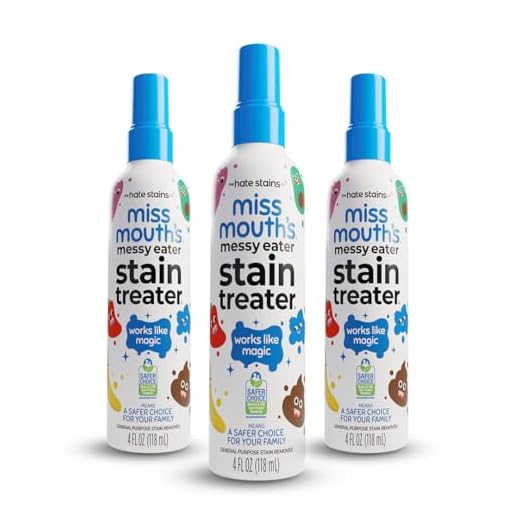



If you love using coconut oil for cooking or beauty purposes, you’ve probably experienced the frustration of accidentally spilling it on your clothes. Coconut oil stains can be stubborn and difficult to remove, but with the right tips and tricks, you can successfully get rid of them and save your favorite outfit.
One of the first things to remember when dealing with coconut oil stains is to act quickly. The longer the stain sits on the fabric, the harder it will be to remove. Start by blotting the stain gently with a clean cloth or paper towel to absorb as much of the oil as possible. Avoid rubbing the stain, as this can spread it further and make it more difficult to remove.
Next, apply a small amount of liquid dish detergent directly to the stain and gently work it into the fabric using your fingers or a soft brush. Let the detergent sit on the stain for a few minutes to penetrate the oil. Then, rinse the fabric with warm water and check if the stain has lightened.
If the stain is still visible, you can try using a stain remover or pre-treating the fabric with a mixture of white vinegar and water. Create a solution using equal parts of vinegar and water, then apply it to the stain and let it sit for about 15 minutes. Rinse the fabric again and wash it as usual.
Remember to check the care label on your clothes before attempting any stain-removal method, as certain fabrics may require specific treatment. With these easy tips and tricks, you can say goodbye to coconut oil stains and keep your clothes looking fresh and clean.
Understanding Coconut Oil Stains
Coconut oil is a popular ingredient in cooking and skincare products, known for its moisturizing and nourishing properties. However, despite its many benefits, coconut oil can leave stubborn stains on clothing. Understanding how coconut oil stains work can help you effectively remove them from your clothes.
Why Coconut Oil Stains Clothes
Coconut oil is a greasy substance that can easily transfer onto fabrics and cause stains. When coconut oil comes into contact with clothing, it quickly seeps into the fibers and leaves behind a greasy residue. The greasy residue can trap dirt and other particles, making the stain even more noticeable.
Characteristics of Coconut Oil Stains

Coconut oil stains on clothes typically have the following characteristics:
- Greasy or oily appearance
- Translucent or yellowish color
- Soft and oily texture
- Strong and distinct coconut smell
Challenges of Removing Coconut Oil Stains
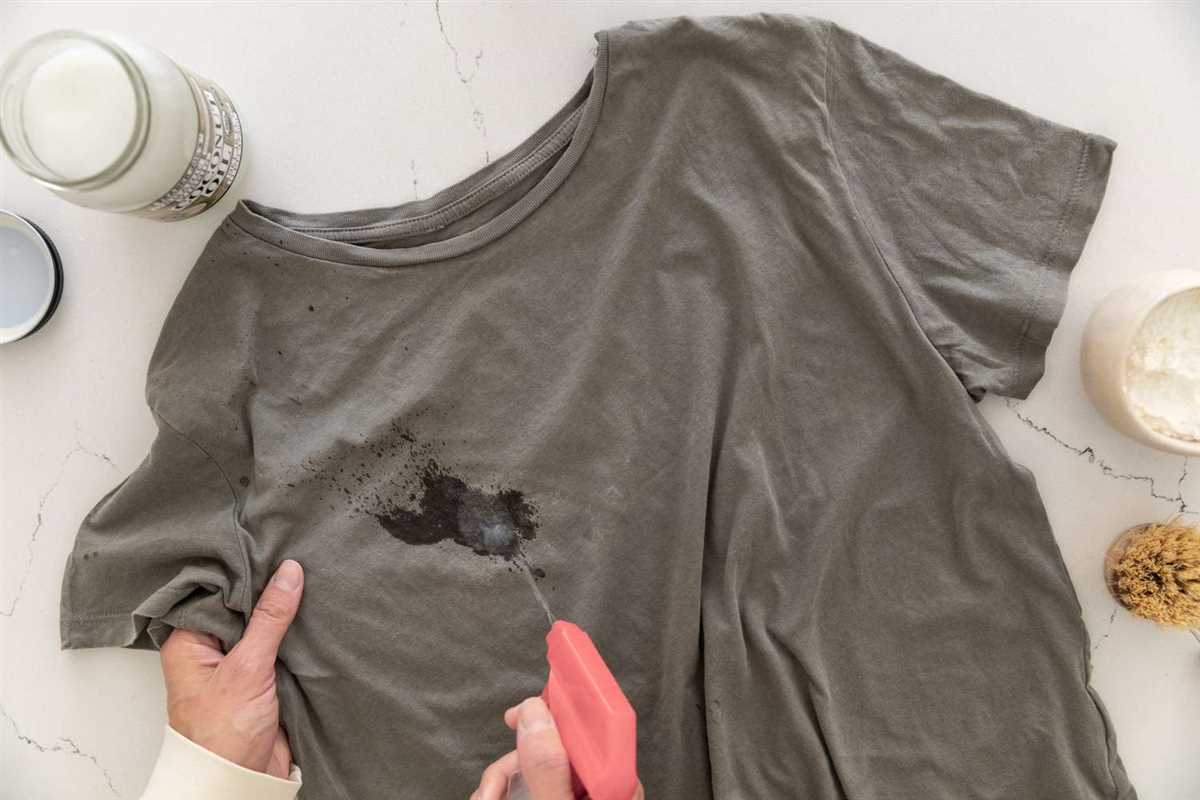
Coconut oil stains can be particularly challenging to remove due to their greasy and oily nature. Regular laundry detergents may not be effective at breaking down the oil and fully removing the stain. Additionally, if the stained garment is not treated promptly, the oil can penetrate deeper into the fabric and become even more difficult to remove.
Preventing Coconut Oil Stains
To prevent coconut oil stains on clothes, it’s important to take precautions when using coconut oil. Here are some tips to help you avoid stains:
- Apply coconut oil to your skin after getting dressed.
- Avoid using excessive amounts of coconut oil.
- Allow the coconut oil to fully absorb into your skin before coming into contact with clothing.
- Wear a protective apron or cover your clothes with a towel when cooking with coconut oil.
By following these preventive measures, you can minimize the chances of getting coconut oil stains on your clothes.
Preventing Coconut Oil Stains
Coconut oil stains can be quite stubborn and difficult to remove from clothes. However, there are some preventive measures you can take to minimize the chances of getting coconut oil stains in the first place.
1. Be cautious while applying coconut oil
- When applying coconut oil, be careful not to apply too much, as an excess amount can be more likely to transfer onto your clothes.
- Avoid applying coconut oil directly on your clothes. Instead, apply it on your skin or hair, and allow it to absorb before putting on your clothes.
2. Use a towel or napkin
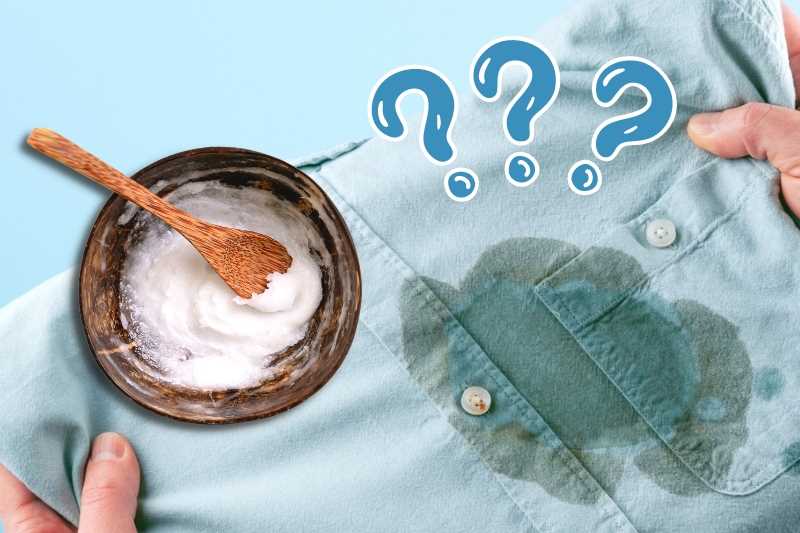
- Before getting dressed, use a towel or napkin to gently blot any excess coconut oil off your body.
- This will help to remove some of the oil, reducing the chances of it transferring onto your clothes.
3. Protect your clothes
- If you’re planning to apply coconut oil on a regular basis, consider wearing a protective garment, such as a robe or an old t-shirt, to prevent oil stains on your clothes.
- This way, even if some oil does transfer, it will be on a garment that you don’t mind getting stained.
4. Wait for the oil to absorb
- After applying coconut oil, wait for a few minutes to allow it to fully absorb into your skin or hair.
- By giving it some time to absorb, you’ll reduce the chances of the oil transferring onto your clothes.
5. Wash your hands properly
- After applying coconut oil, thoroughly wash your hands with soap and warm water.
- This will help to remove any residual oil on your hands that could potentially transfer onto your clothes.
By following these preventive measures, you can significantly reduce the likelihood of getting coconut oil stains on your clothes.
Methods for Removing Coconut Oil Stains
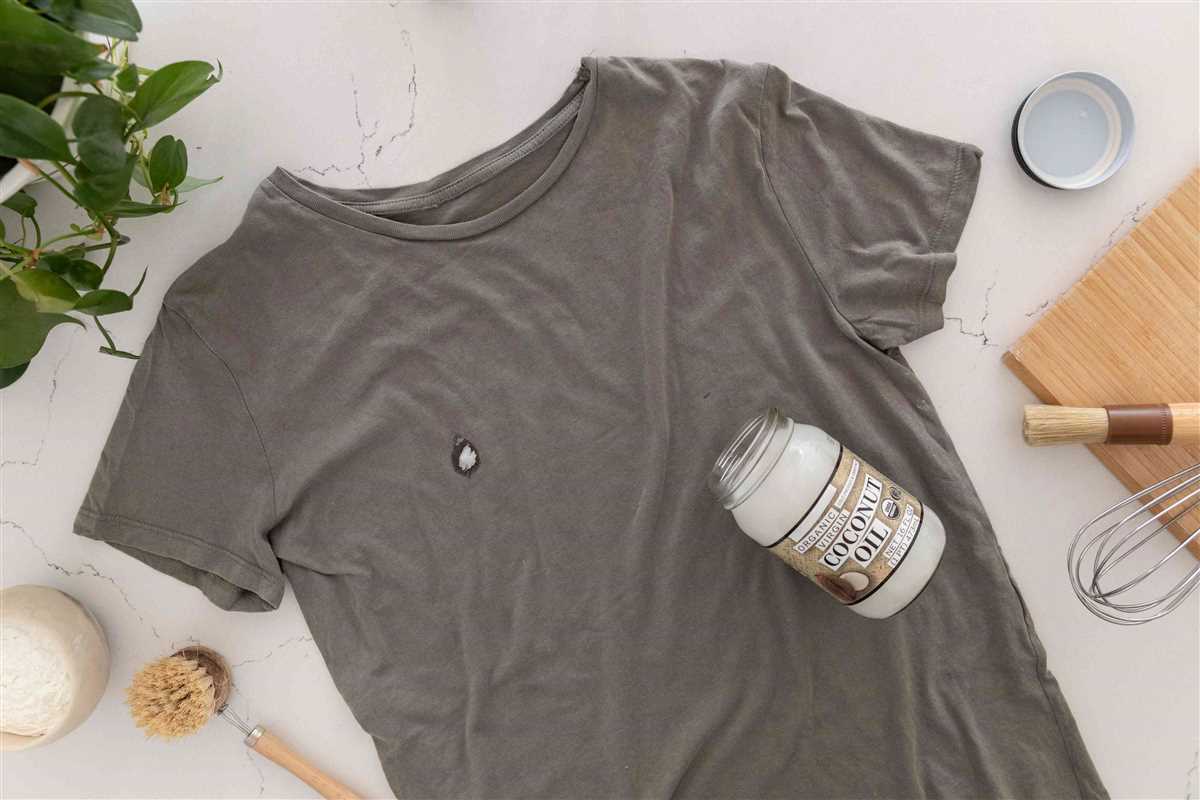
- Dish detergent method: This method is effective for fresh coconut oil stains. Start by blotting the excess oil with a paper towel. Then, apply a few drops of dish detergent directly onto the stain. Gently rub the detergent into the fabric using your fingers or a soft brush. Let it sit for about 15 minutes before washing the garment as usual.
- Baking soda method: Baking soda is a versatile product that can help absorb oil stains. Sprinkle a generous amount of baking soda onto the stain and gently rub it into the fabric. Leave it on for at least 30 minutes, or preferably overnight. Afterwards, shake off the excess baking soda and wash the garment as you normally would.
- Cornstarch or baby powder method: Similar to baking soda, cornstarch or baby powder can absorb oily stains. Cover the stain with a thick layer of cornstarch or baby powder, making sure to completely coat the affected area. Let it sit for several hours or overnight. Then, brush off the powder and wash the garment as usual.
- Dishwashing liquid and warm water method: This method is suitable for both fresh and set-in coconut oil stains. Mix a few drops of dishwashing liquid with warm water to create a soapy solution. Dab the stained area with a clean cloth soaked in the soapy water. Blot, do not rub, the stain until it starts to lift. Rinse the area with clean water and launder the garment as normal.
- Pre-wash stain remover method: Pre-wash stain removers are designed to tackle tough stains, including coconut oil. Apply the pre-wash stain remover directly onto the stain, following the product instructions. Let it sit for the recommended time before laundering the garment as usual.
- Vinegar method: Vinegar is known for its ability to break down oil stains. Mix equal parts vinegar and water in a spray bottle. Spray the solution directly onto the stain and let it sit for a few minutes. Blot the stain with a clean cloth to lift the oil. Rinse the area with clean water and wash the garment as normal.
- Commercial stain remover method: If none of the above methods work, you can try using a commercial stain remover specifically designed for oil-based stains. Follow the product instructions for best results.
It is important to always read the care label of the garment and test any stain-removal method on a small, inconspicuous area to ensure it does not cause any damage or discoloration.
Note: Some stubborn oil stains may require multiple treatments and washes to completely remove. Patience and persistence are key when dealing with tough stains.
Using Dish Soap
One of the easiest and most effective ways to remove coconut oil stains from clothes is by using dish soap. Dish soap is designed to break down grease and oil, making it ideal for getting rid of stubborn coconut oil stains.
Here’s how you can use dish soap to remove coconut oil stains from clothes:
- Gently scrape off any excess coconut oil from the fabric using a spoon or a butter knife. Be careful not to rub the stain further into the fabric.
- Wet the stained area with warm water.
- Apply a small amount of dish soap directly to the stain. Rub the soap into the fabric gently with your fingers or a soft brush.
- Let the dish soap sit on the stain for about 5 minutes to allow it to penetrate the fabric.
- Fill a basin or sink with warm water and submerge the stained clothing item. Swish it around gently to help remove the stain.
- Rinse the fabric thoroughly under running water to remove all traces of dish soap.
- If the stain persists, repeat the process or try using a stain remover specifically designed for removing oil stains.
- Once the stain is gone, launder the clothing item as usual and allow it to air dry.
Using dish soap is a simple and effective method for removing coconut oil stains from clothes. Make sure to act quickly and treat the stain as soon as possible for the best results.
Applying Baking Soda
If you have a fresh coconut oil stain on your clothes, one effective way to remove it is by using baking soda. Baking soda, also known as sodium bicarbonate, is a natural cleaning agent that can absorb oil stains.
Step 1: Blotting
Before applying baking soda, gently blot the excess coconut oil with a clean cloth or paper towel. Avoid rubbing, as it may spread the stain further.
Step 2: Sprinkling Baking Soda
Generously sprinkle baking soda directly onto the coconut oil stain. Make sure to cover the entire affected area.
Step 3: Patting
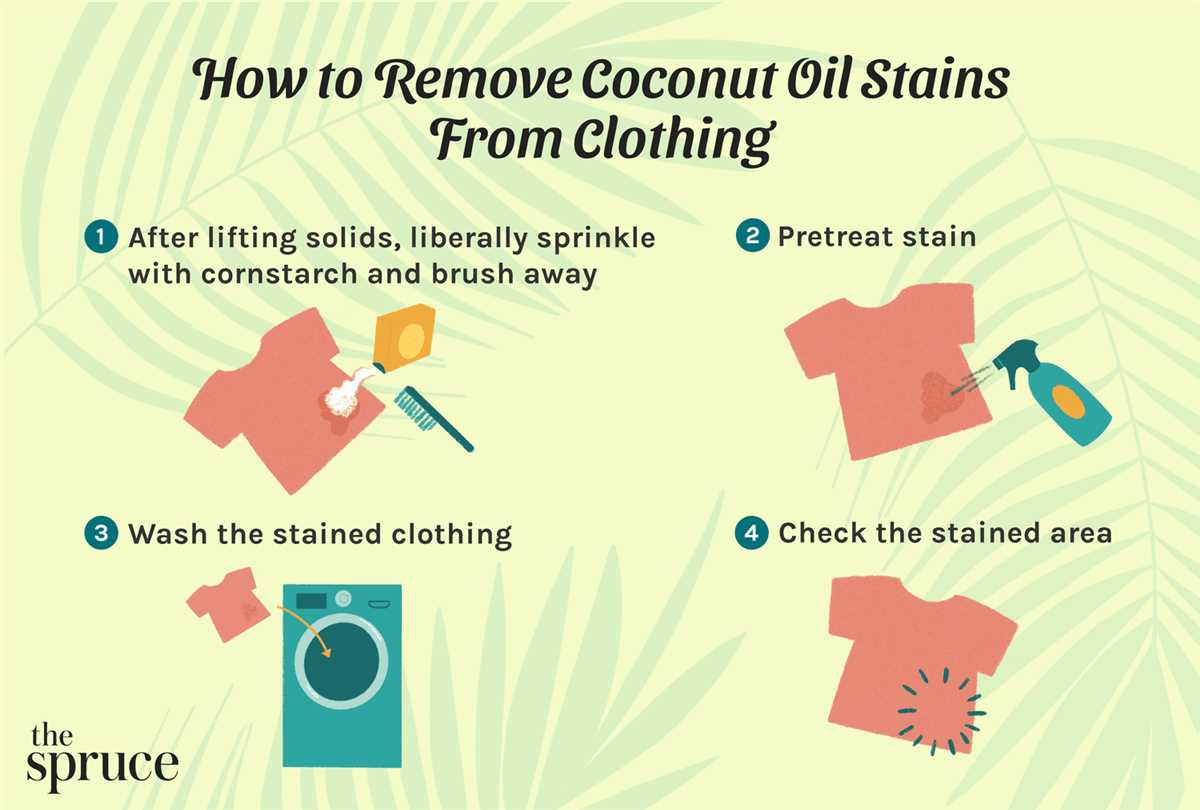
Use your fingers or a soft brush to pat the baking soda into the stain. This helps the baking soda absorb the oil and break down the stain.
Step 4: Letting it Sit
Allow the baking soda to sit on the stain for at least 30 minutes. This gives it enough time to work on the oil and lift it from the fabric.
Step 5: Brushing off Excess

After the baking soda has had time to work, use a soft brush or cloth to brush off the excess powder. This will also help remove any loosened oil particles.
Step 6: Washing
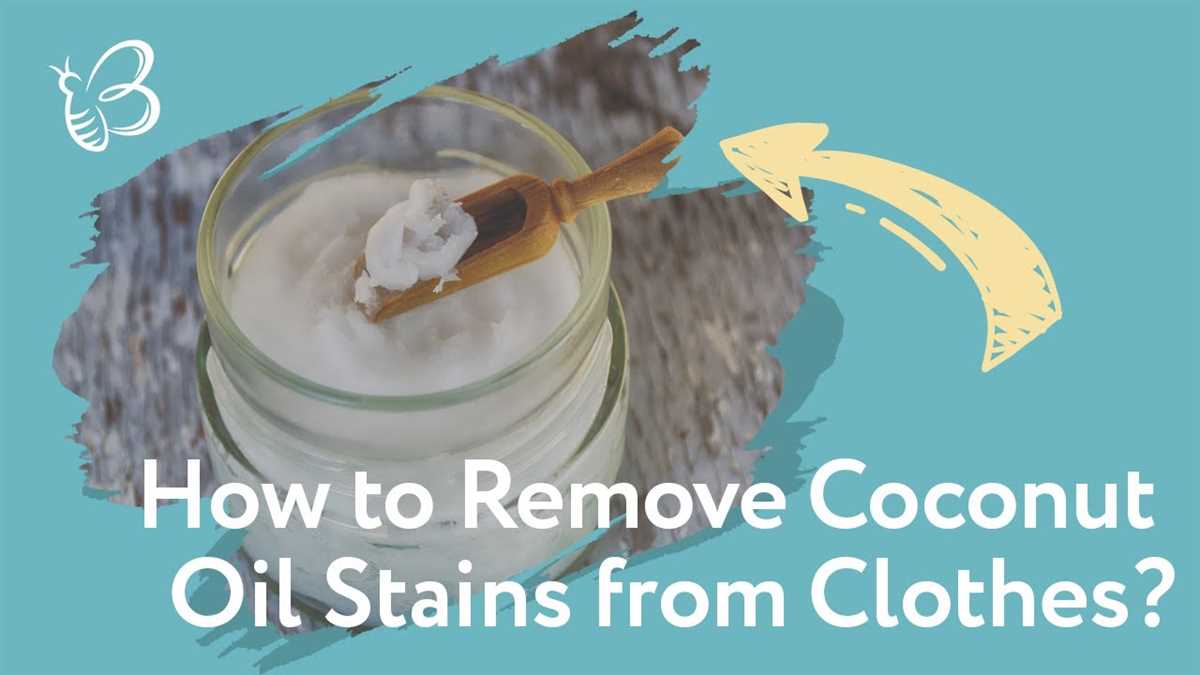
Finally, launder the stained garment as usual. Check the care label for instructions on the appropriate temperature and cycle for washing.
If the stain persists after washing, do not place the garment in the dryer as the heat can set the stain further. Instead, repeat the baking soda treatment or try another stain removal method.
- Baking soda is an effective natural cleaner for various types of stains, including coconut oil.
- Always read and follow the care label instructions on your garments before attempting to remove stains.
- Do a spot test on a hidden part of the fabric before applying baking soda to ensure it does not damage or discolor the material.
- For older or stubborn coconut oil stains, you may need to repeat the baking soda treatment or try a different stain removal method.
Using Stain Remover
If you have a stubborn coconut oil stain on your clothes, using a stain remover can help break down the oil and make it easier to remove. Follow these steps to effectively use a stain remover:
- Choose the right stain remover: There are various stain removers available in the market, such as spray-on stain removers, gel stain removers, or even homemade solutions like dish soap or baking soda. Choose the one that suits your preference and the nature of the coconut oil stain.
- Pre-treat the stain: Before washing the stained garment, pre-treat the coconut oil stain with the chosen stain remover. Read the instructions on the stain remover packaging carefully before applying it to the stain.
- Apply the stain remover: Apply the stain remover directly to the coconut oil stain. Make sure to cover the entire stained area with the stain remover and gently rub it into the fabric using your fingertips or a soft brush. This will help the stain remover penetrate the fabric and break down the oil.
- Let it sit: Allow the stain remover to sit on the coconut oil stain for the recommended duration mentioned on the packaging. This will give the stain remover enough time to work on the stain and loosen the oil particles.
- Wash as recommended: After the recommended time, proceed to wash the garment as usual. Follow the washing instructions on the clothing label, making sure to use the recommended water temperature and laundry detergent.
- Check for stain removal: Once the garment is washed, check if the coconut oil stain has been completely removed. If there is still some residue left, repeat the stain removal process or try a different stain remover.
- Avoid drying the clothes: If the stain is not completely removed after washing, avoid drying the clothes, as heat can set the stain and make it harder to remove. Instead, repeat the stain removal process and wash the garment again before drying.
Using a stain remover can be an effective method to remove coconut oil stains from clothes. Remember to always test the stain remover on a small, inconspicuous area of the fabric first to ensure it does not cause any damage or discoloration.
Trying Dry Cleaning Solvent
If you’re dealing with a stubborn coconut oil stain on your clothes, you may want to consider trying a dry cleaning solvent. Dry cleaning solvents are designed to remove tough stains and can be effective in breaking down the oil particles in coconut oil stains.
Here’s how you can use dry cleaning solvent to remove coconut oil stains from your clothes:
- Start by blotting the stain with a clean cloth or paper towel to remove any excess oil.
- Place a clean cloth or towel underneath the stained area to protect the fabric underneath.
- Apply a small amount of the dry cleaning solvent directly onto the stain.
- Gently blot the stain with a clean cloth, working from the outside of the stain towards the center. Avoid rubbing, as this can spread the stain further.
- Continue blotting until the stain starts to lift.
- Rinse the area with cold water to remove any remaining solvent and blot dry.
It’s important to note that dry cleaning solvents can be harsh on certain fabrics, so always check the care label of your clothing before using any solvents. Additionally, it’s recommended to test the solvent on a small, inconspicuous area of the garment before treating the stain.
If the stain persists after using dry cleaning solvent, you may need to repeat the process or try an alternative method. Remember to always follow the instructions provided by the manufacturer of the solvent and take proper safety precautions when using these products.
FAQ
What is the best way to remove coconut oil stains from clothes?
The best way to remove coconut oil stains from clothes is to immediately blot the stain with a clean cloth or paper towel to remove as much oil as possible. Then, apply a pre-wash stain remover or liquid laundry detergent directly to the stain and let it sit for 10-15 minutes. After that, wash the garment in hot water with laundry detergent, and check if the stain is completely removed before drying.
Can I use dish soap to remove coconut oil stains?
Yes, dish soap can be effective in removing coconut oil stains from clothes. Apply a small amount of dish soap directly to the stain, gently rub it in, and let it sit for 10-15 minutes. Then, wash the garment in hot water with laundry detergent as usual. The dish soap helps to break down the oil and remove it from the fabric.
What if the coconut oil stain has already dried?
If the coconut oil stain has already dried, you can still try to remove it. Start by scraping off any excess oil with a spoon or dull knife, being careful not to spread the stain further. Then, apply a pre-treatment stain remover or liquid laundry detergent directly to the stain and let it sit for at least 30 minutes. After that, wash the garment in hot water with laundry detergent and check if the stain is completely gone before drying.
Are there any home remedies to remove coconut oil stains?
Yes, there are some home remedies that can help remove coconut oil stains from clothes. One option is to sprinkle cornstarch or baby powder onto the stain and let it sit for a few minutes to absorb the oil. Then, brush off the powder and wash the garment as usual. Another option is to mix equal parts of vinegar and water, apply it to the stain, and let it sit for 10-15 minutes before washing. However, it’s important to note that these home remedies may not be as effective as commercial stain removers.












